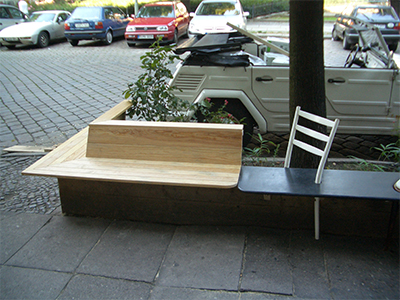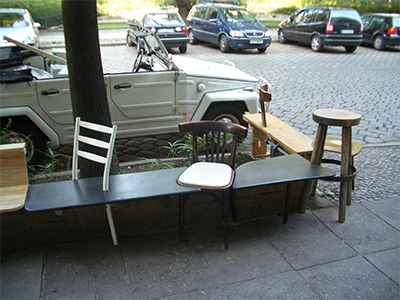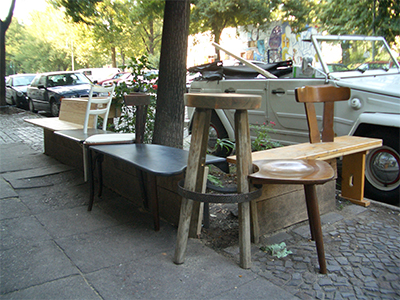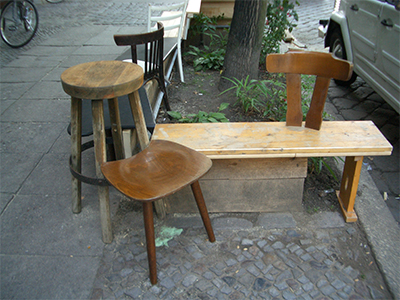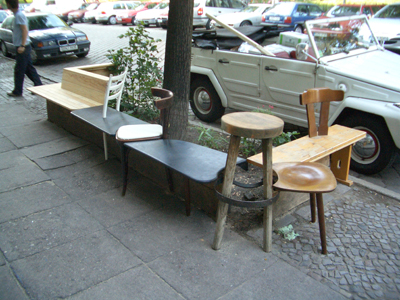Berlino Bench
2004
Berlin, De
A summer bench in Berlino made with Rainer Spehl.
www.rainerspehl.com
Woodlands
2002
Bloomberg Headquarters, London, Uk
With Rainer Spehl & åbäke
Four Degrees of Together-ness by Karl-Johan Dykinte, 2004
Don’t you always believe graphic designers, especially if they tell you ‘We even make furniture’—double emphasis on the even, to stress there is more. In these days of Breaking the Boundaries of Not only Multi-disciplinary But Plurally Talented/Can sing Too-ness, these words are easily pronounced. I can predict the return of special skills, the hyper narrow savoir faire as a reaction to those who pretend being able to cabinet-make while designing typography. Please allow me to study the case of Woodlands, a joint project between furniture designers Martino Gamper, Rainer Spehl and graphic designers Åbäke. Woodlands is a series of semi-public furniture commissioned by design curators Scarlet Projects in the summer of 2002. The place is the Bloomberg UK
headquarters, in London. In this fancy building, there is no escape. The employees have four screens each and are informed in the staircases and in the toilets by invisible speakers. The nature of what they do —a mystery to me— necessitates it. The information is too important to miss any of it. There is a space, tho’, on each of the four floors to display functional design: a place to sit on ‘experimental’ furniture. Why this interests me is because the four sub-projects, developed for each of the four spaces constitute different examples of collaborations; an all-too democratic and genteel word used to define what is very often the best way to get cheap labour by unscrupulous people.
Floor one, the Tape Woods.
A few years back, Martino had started his Amalgam series by going to the then trendy A.P.C. shop where he bought some camouflage tape to amalgamate pieces of furniture. After a while, he opted to make his own ‘fake wood’ tape of which were rolls and rolls left when the Scarlet/Bloomberg commission happened. It might be worth mentioning the overall idea was to loosely bring nature into an artificial space. So they went scavenging to try and transform the broken & ugly into the new & pretty. Although it seems that in this instance, Martino set the rules while others executed, the varying results, from Flash Gordon the Movie props to decent 3 digit priced pieces showed they all might have had fun. Here, there can be some satisfaction in playing by someone elses rules.
Floor two, the Skulk of Foxes.
A few months back, Åbäke had started their Fox-objects series by printing fox-fur stickers to ‘cover’ objects. So they went scavenging to try and transform the broken & ugly into the new & pretty. Although it seems that in this instance, Åbäke set the rules while others executed, the varying results, from kids toys made by kids to tables I could swear were alive showed they all might have had fun. Here again, there can be some satisfaction in playing by someone elses rules.
Floor three, the Log.
For this one, nobody seems to remember who said ‘log’ in a meeting –or did someone say tree trunk? For the sake of demonstration and because it matters little, I decide Rainer said it. By then the 6 had already shifted most of the budget to this floor and the next because the foxes and the tape woods had minimal cost. They could allow themselves with something a bit more expensive. Once the L-word was agreed on, Rainer and Martino set off drawing it and involved ‘Clive the upholsterer’ to make the leather finish. In this collaboration, an idea is thrown in the middle of the committee and it gets naturally executed by a skilled craftsman. Because of its furniture-like nature, one could quite rightly assume that it is more of a Rainer and Martino piece.
Floor four, the Rabbit.
As all the other floor are featuring seats, this one did too. The Rabbit, which is four by three meters long has been sewn on a small machine which luckily didn’t break. It might have been a reaction to the hard log but this huge beanbag was surely soft. The fabric was hand drawn and featured a few animal faces mixed with furry surfaces. In principle, one could make animals with different body shapes. It worked as long as there was an eye or a beak where the head should be on the toy. The fact this piece of furniture is a flabby bean bag and print oriented makes it the perfect candidate for graphic designer to try out some ‘furniture design’. This being possible, of course, under the guidance of Royal College of Art-trained guys like Martino and Rainer. I am not saying it is easier but ok, it is.
All opinions expressed are mine.
www.rainerspehl.com www.abake.fr
Furniture I've Always Wanted To Make
27 – 28 March 2004
M + R Gallery, London, Uk
We Make Remake - Petrified
2002
Retrovius, London, Uk
Immediately after the second Village Fete, Rainer and Martino started to develop more and more what they now called the We Make Remake project. Within 6 months (Autumn–Winter 2002), they have ‘re-made’, exhibited and sold more than 50 unique pieces of furniture.
All the pieces shown are from Petrified, a show organised by Retrouvius, an Architectural Reclamation and Design partnership formed by Adam Hills and Maria Speake, ‘working for the past decade to promote salvage and re-use’.
www.rainerspehl.com www.retrouvius.com
Waste to Taste
13 – 21 February 2003
Sotheby's, London, Uk
Before the end of Petrified, Martino and Rainer were commissioned to make unique pieces for the Waste to Taste exhibition at Sotheby’s Contemporary Show 2003
www.rainerspehl.com
Walking Carpet
Eddie Mundy and Martino Gamper’s carpet flip flop stall at the 2003 V&A Village Fete
(Martino takes the photo while Eddie convinces a potential customer).
Coming Home
2002
Made in collaboration with Rainer Spehl
In 2002, the world cup matches filled the pubs. Meanwhile, Martino and Rainer Spehl designed the football lamp; a limited edition of 100 specially manufactured football lights. After a nice display at the London Design Museum, the first Table Football Competition under the Football Lamp Chandelier was played at Café Kick in Hoxton. Twelve teams participated but DEATH (Nic Barba and Sean Murphy) ultimately embraced Victory which came with a lamp and a t-shirt for each member of the team.
www.rainerspehl.com
Furniture While You Wait
2001
Workshop at the Victoria and Albert Museum's Village Fête, London, Uk
Martino and Friends by Claire Catterall 2004
Furniture While U Wait, 2001
Among the various stalls on rickety trestle tables at the Victoria & Albert Museum’s Village Fete in 2001, Martino Gamper and Rainer Spehl set up shop making Furniture While U Wait. They had spent the previous two weeks scavenging for odd bits and pieces of wood, abandoned furniture and other old junk including a guitar, a tennis racket, roller skates and a football. It turns out to be a blisteringly hot day. Martino and Rainer busily get to work hammering odd pieces of wood and found objects together — cannibalising, rearranging, juxtaposing, and reassembling—to punter’s specifications. What emerges is a strange hybrid of office furniture, G-plan and Victorian drawing room, with an odd leg that on closer inspection turns out to be a skittle. The stall is a runaway success—Ron Arad insists on doing a turn as cabinetmaker; the V&A buys a couple of pieces for its Permanent Collection; Stephen Bayley gives Furniture While U Wait the Fete’s prestigious ‘Most Witty Stall’ award. In the searing heat, and inundated with orders, Martino accidentally cuts his hand and faints. But even this fails to dampen spirits and production continues at a rapid pace.
Just what is it about these pieces of furniture that makes them so appealing? Is it the memories they evoke—the chair leg that reminds you of schooldays; the upholstery that takes you back to your grandmother’s front room; the plastic seat that you’ve seen a million times in various church halls and waiting rooms? Or perhaps it’s the strange and sometimes surreal juxtaposition of elements—the guitar used as a seat back with an office chair on wheels, or the tubular steel cantilever frame teamed with a cabriole leg and brass claw foot. Maybe it has something to do with the way they’re produced—part factory assembly line, part game of Exquisite Cadaver, part drive-through takeaway. Or maybe it’s the spontaneity of the process, the way that something will be created in a matter of minutes. More likely it’s quite simply all of the above, and, of course, the idea that furniture can be ‘born’ rather than ‘designed’.
By the end of the day a large family of furniture has amassed roundthe stall, replacing the piles of wood, pieces of junk and second hand furniture that had been there before. It’s a collection of odd misfits, precarious pairings, and uncomfortable angles—stray creatures waiting to be claimed and taken home by their new owners.Has the V&A put the pieces they bought for their Permanent Collection on display? ‘No, we’re not quite sure what to do with them—they’re still in our office. We use them every day, though. They’re more like old friends.’
